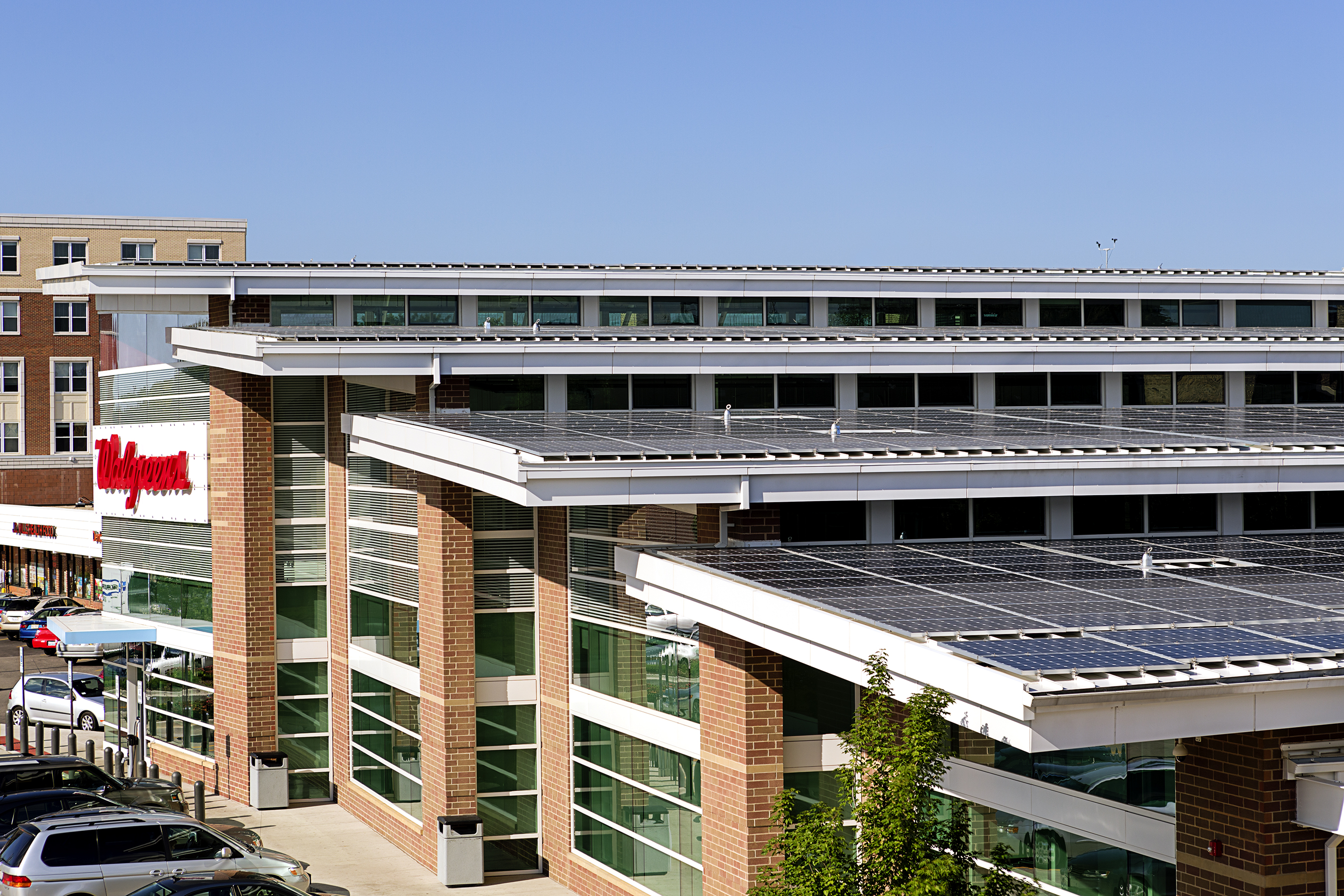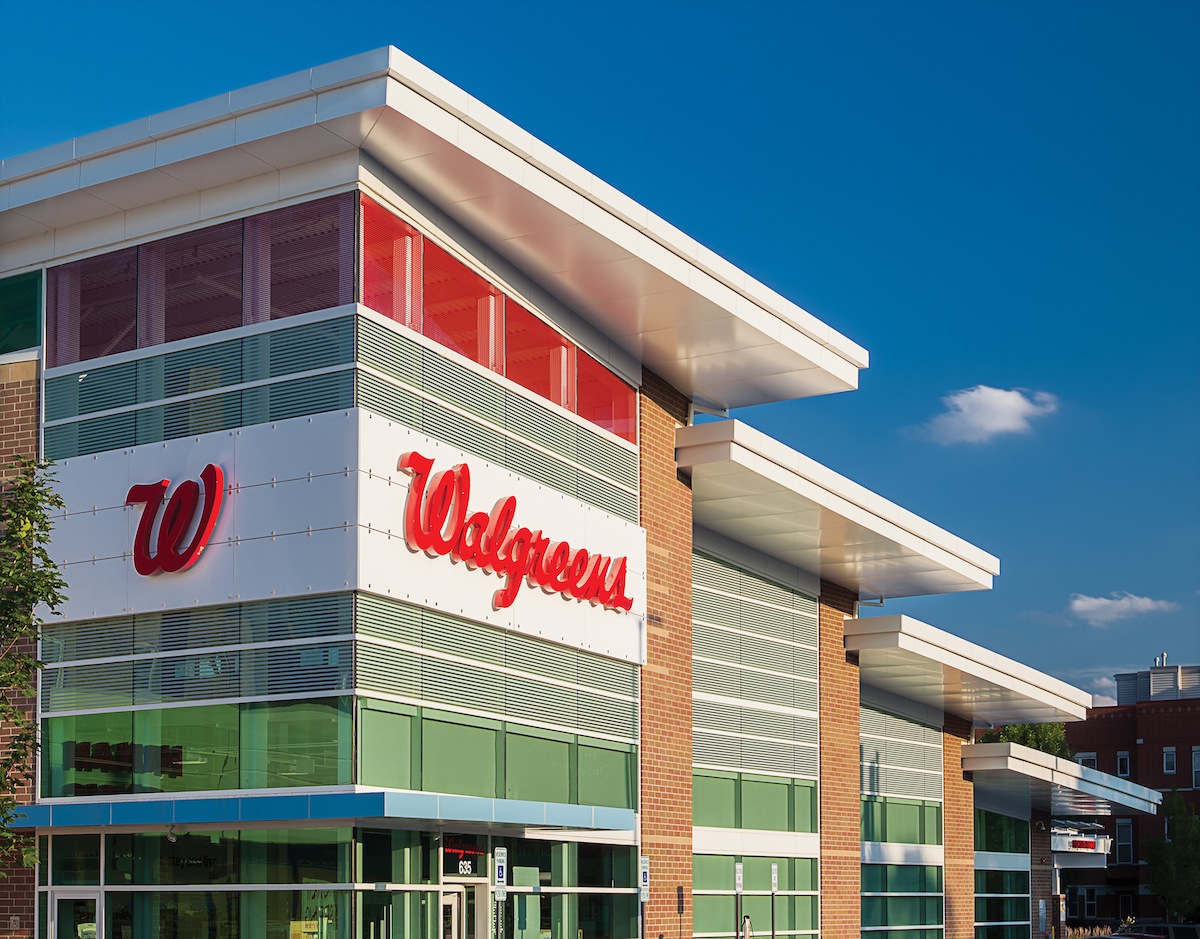Design of the nation’s first zero net energy retail store elevates the typical Walgreens shopping experience from one of convenience to relevance. The new store in Evanston, Ill., features metal and composite material from Petersen Aluminum Corp., and a roof made of tiered sections that support almost 850 solar panels. The clever building design includes enough sustainable features to attempt to earn LEED Platinum status.
The store’s architecture is open and inviting, according to the design by John Bradshaw, licensed architect/planner at Camburas and Theodore Architects in Des Plaines, Ill., and those on his team. The design required roughly 33,000 sq. ft. of Petersen bone white steel coil, plus 7,600 sq. ft. of Reynobond composite panels for the soffits, edge trim and the backdrop that frames the lighted Walgreens signs above the main entrance. Sheet Metal Supply in Mundelein, Ill., roll-formed custom 13-in.-wide roof panels to accommodate the solar panel mounting system. Petersen’s ability to stock coil in non-standard widths reduced scrap and saved money.
The best feature of the building, in Bradshaw’s opinion, is the amount of daylighting. “The clerestory windows at each segment of the roof that we used for daylight harvesting, with the cantilevered roof segments that shade summer sun and provide maximum roof area for the solar panels, the segmented walls that break apart to allow even more daylight harvesting – all these elements acting together created the best look on the building,” he insisted.
The vision for the building incorporated the elements of green design such as daylight harvesting, solar panel arrays and a mechanical mezzanine. “It was our mission to incorporate these items in a meaningful design but, more importantly, to celebrate this new icon of sustainability and to promote its virtues with a design that lifted the typical Walgreens to a new height, both literally and figuratively,” Bradshaw said.
 850 roof-top solar panels attached to metal roof.
850 roof-top solar panels attached to metal roof.
Bradshaw prefers working with Petersen Aluminum products. “Truly, Petersen Aluminum is one of the most trusted products that we specify. We have never had a performance issue with the products, the color selections are broad and they are local, which suits almost all of our needs,” he said.
Inconveniently positioned power lines over an urban lot with restrictions on all sides contributed to a challenging work site, said Chuck Heintzelman of installing contractor WBR Roofing in Wauconda, Ill. “We simply worked around our surroundings like we always do, and made it work,” he said. Regarding Petersen products, Heintzelman added, “We enjoy using PAC-Clad products. Plus, it’s great to be part of a LEED building.”
In addition to the nearly 850 roof-top solar panels that generate enough energy to power 30 Illinois homes for a year, the Walgreens store also includes:
- Two 35-ft.-tall wind turbines, using Lake Michigan breezes to generate enough power to offset annual greenhouse gas emissions from 2.2 passenger vehicles;
- Geothermal energy obtained by drilling 550 feet into the ground below the store, where temperatures are more constant and can be tapped to heat or cool the store in winter and summer;
- LED lighting and daylight harvesting;
- Carbon dioxide refrigerant for heating, cooling and refrigeration equipment;
- Energy efficient building materials.
Engineering estimates – which can vary due to factors such as weather, store operations and systems performance – indicate that the store will use 200,000 kilowatt hours per year of electricity while generating 220,000 kilowatt hours per year.
Thomas Connolly, Walgreens vice president of facilities development, said, “We are investing in a net-zero energy store so we can bring what we learn to our other stores and share what we learn with other companies. Because we operate more than 8,000 stores, anything we do that reduces our carbon footprint can have a broad, positive impact on the nation’s environment.”
Sheet Metal Supply in Mundelein, Ill., supplied the metal for the roof panels. The general contractor was Osman Construction Corp. in Arlington Heights, Ill.
To learn more about the Walgreens net zero energy store in Evanston, Ill., visit this page.
Related Stories
| Jan 4, 2011
LEED 2012: 10 changes you should know about
The USGBC is beginning its review and planning for the next version of LEED—LEED 2012. The draft version of LEED 2012 is currently in the first of at least two public comment periods, and it’s important to take a look at proposed changes to see the direction USGBC is taking, the plans they have for LEED, and—most importantly—how they affect you.
| Jan 4, 2011
California buildings: now even more efficient
New buildings in California must now be more sustainable under the state’s Green Building Standards Code, which took effect with the new year. CALGreen, the first statewide green building code in the country, requires new buildings to be more energy efficient, use less water, and emit fewer pollutants, among many other requirements. And they have the potential to affect LEED ratings.
| Jan 4, 2011
Furniture Sustainability Standard - Approved by ANSI and Released for Distribution
BIFMA International recently announced formal American National Standards Institute (ANSI) approval and release of the ANSI/BIFMA e3-2010 Furniture Sustainability Standard. The e3 standard represents a structured methodology to evaluate the "sustainable" attributes of furniture products and constitutes the technical criteria of the level product certification program.
| Dec 20, 2010
Architect Adrian D. Smith on zero-energy cities, new technologies, and high density.
Adrian D. Smith, FAIA, RIBA, is co-founder (with Gordon Gill) of Adrian Smith + Gordon Gill Architecture, Chicago. Previously, he was a design partner in the Chicago office of Skidmore, Owings & Merrill (1980-2003) and a consulting design partner from 2004 to 2006. His landmark structures include the Jin Mao Tower (Shanghai), Rowes Wharf (Boston), and Burj Khalifa (Dubai, U.A.E.), the world’s tallest structure. He recently collaborated with Gordon Gill to design the world’s first net-zero-energy skyscraper, Pearl River Tower, now nearing completion in Guangzhou, China. This account is based on his recent remarks at the Illinois Institute of Technology.
| Dec 17, 2010
Gemstone-inspired design earns India’s first LEED Gold for a hotel
The Park Hotel Hyderabad in Hyderabad, India, was designed by Skidmore, Owings & Merrill to combine inspirations from the region’s jewelry-making traditions with sustainable elements.
| Dec 17, 2010
Alaskan village school gets a new home
Ayagina’ar Elitnaurvik, a new K-12 school serving the Lower Kuskikwim School District, is now open in Kongiganak, a remote Alaskan village of less than 400 residents. The 34,000-sf, 12-classroom facility replaces one that was threatened by river erosion.
| Dec 17, 2010
New engineering building goes for net-zero energy
A new $90 million, 250,000-sf classroom and laboratory facility with a 450-seat auditorium for the College of Electrical and Computer Engineering at the University of Illinois at Urbana/Champaign is aiming for LEED Platinum.
| Dec 17, 2010
Vietnam business center will combine office and residential space
The 300,000-sm VietinBank Business Center in Hanoi, Vietnam, designed by Foster + Partners, will have two commercial towers: the first, a 68-story, 362-meter office tower for the international headquarters of VietinBank; the second, a five-star hotel, spa, and serviced apartments. A seven-story podium with conference facilities, retail space, restaurants, and rooftop garden will connect the two towers. Eco-friendly features include using recycled heat from the center’s power plant to provide hot water, and installing water features and plants to improve indoor air quality. Turner Construction Co. is the general contractor.
| Dec 13, 2010
Energy efficiency No. 1 priority for commercial office tenants
Green building initiatives are a key influencer when tenants decide to sign a commercial real estate lease, according to a survey by GE Capital Real Estate. The survey, which was conducted over the past year and included more than 2,220 office tenants in the U.S., Canada, France, Germany, Sweden, the UK, Spain, and Japan, shows that energy efficiency remains the No. 1 priority in most countries. Also ranking near the top: waste reduction programs and indoor air.
| Dec 7, 2010
USGBC: Wood-certification benchmarks fail to pass
The proposed Forest Certification Benchmark to determine when wood-certification groups would have their certification qualify for points in the LEED rating systemdid not pass the USGBC member ballot. As a result, the Certified Wood credit in LEED will remain as it is currently written. To date, only wood certified by the Forest Stewardship Council qualifies for a point in the LEED, while other organizations, such as the Sustainable Forestry Initiative, the Canadian Standards Association, and the American Tree Farm System, are excluded.












